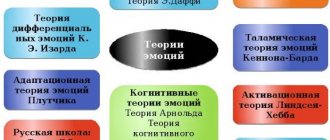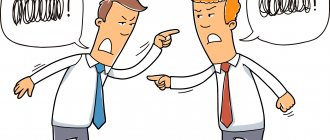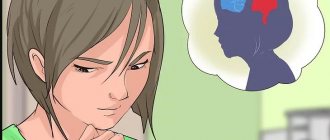Definition of expression in psychology
Expression is, in psychology, the expression of one’s feelings and emotions, showing one’s internal state through external expression:
- facial expressions;
- gestures;
- speech coloring.
The concepts of expressiveness and expression are applicable not only in psychology in relation to a person’s character and the characteristics of his behavior, but are also used in the creative field - art, theater, cinema.
Interest in the expressive type of behavior grew with the accumulation of knowledge in psychology and specifically in this topic. Art critics and philosophers have long seen the dependence of expression on the individual’s state of mind, his tendency to actively express emotions.
Today, experts unanimously agree that there is a very close relationship between a person’s inner world and the manifestation of expressiveness.
The concept opposite to expressiveness is impressiveness - a predisposition to the internal accumulation of emotions (mostly negative), rather than to their external expression. It is customary to say about such people that they tend to keep everything to themselves, suppressing all emotional impulses.
Positive sides
The positive features of the expressive type of character are the following qualities:
- impulsiveness;
- ease;
- communication skills;
- frankness;
- emotional brightness;
- attractiveness;
- aptitude for leadership;
- love of life.
Expressive people love to be the center of attention and take the initiative. This trait helps them in their professional activities, especially if it is related to creativity. Such people cope more easily with troubles and life shocks.
Negative qualities
At the same time, expressiveness also has a number of negative aspects that can interfere with both the person himself and his immediate environment:
- recklessness;
- lack of prudence;
- carelessness;
- inability to feel and understand other people;
- frivolity;
- irresponsibility.
Sometimes expressive people can behave rudely, aggressively filling everything around with themselves and their energy and not giving others the opportunity to speak out and express themselves. They can be excessively noisy, intrusive, straightforward and often neglect the interests of other people.
Other meanings of the term
In addition to its main meaning, the described term has two other meanings, which are also quite actively used in speech. Thus, in the field of art, expression is understood as a strong, both positive and negative feeling, or a range of feelings that arises in an individual when viewing an unusual picture or when listening to exciting music that directly affects his emotions.
In addition, genetic engineers use the concept of “gene expression,” which refers to their activity. Any gene in our body is endowed with its own functions; it performs them to the maximum, to the minimum, or not at all. It is the genome that fulfills its function 100% and is called expression.
Forms of expression, examples
Expression is in psychology the outwardly manifested expression of an individual’s emotions and feelings. It can be expressed in various forms and plays an important role in human communication, as it is important for establishing mutual understanding. People are wary and suspicious of a closed, withdrawn person.
The exchange of emotions is an integral part of social life. Without the opportunity to share their emotions and experiences, a person can fall into a depressed state, feel lost and alone.
Any person himself needs emotional nourishment, the perception of emotional information from other people.
This allows you to fully experience the whole gamut of moods, experiences and feelings, without which it is impossible to feel the fullness of life. Therefore, humanity has developed various forms of demonstrating emotions.
Facial expressions
With the help of facial expressions, or in other words, movements of the facial muscles, a person can convey his mood and state of mind to others as much as possible. The overall facial expression is especially influenced by the eyes and smile.
Expression in psychology can be expressed in facial expressions.
The eyes, as is known, maximally reflect a person’s current mood and are capable of transmitting maximum information to the interlocutor. The look can be full of tenderness or anger, glow with passion or freeze with cold, express respect and contempt.
The expression of a gaze has a very powerful force; it is not without reason that visual interaction allows you to literally “read” the thoughts of another person. Direct, challenging eye to eye gaze usually demonstrates dominance and superiority.
Downcast, averted eyes indicate that a person is not confident in himself or that he has something to hide. Another form of expression is a smile. With its help, you can convey the joy of communicating with your interlocutor and win him over.
A smile can be different in its message - flirting, guilty, arrogant, sincere, and a person who does not suppress his emotional impulses actively uses this expressive tool in life to express emotions.
Pantomime
Pantomime is a combination of facial expressions and bodily movements, poses, and gestures. With this combination, expression is most pronounced. The nature of a person’s gestures and movements at the reflex level changes according to his mood.
Body position, gestures, and gait can reveal a person’s feelings, even if he doesn’t want it to.
| State | Pantomime |
| Anger, rage | Gestures are rude, abrupt, movements are tense and poorly coordinated. |
| Happiness joy | Free and wide gestures, it seems that the person is ready to embrace the whole world. The gait is springy, confident, and the stride is wide. |
| Sadness, depression | There is practically no gesticulation, shoulders are slumped, and the gait is heavy and shuffling. |
The position of your hands can tell you a lot about your mood at the moment. If there is no desire to establish contact, they can be crossed on the chest, or, if annoyed, clenched into fists. If a person is calm and satisfied with everything, then the movements of his hands are round and smooth.
Verbal (speech) expression
The coloring of spoken speeches can convey the mood no less than facial expressions and bodily movements. The speech of expressive people is literally saturated with emotions.
This may be expressed in:
- the use of various forms of words - exaggerated, diminutive;
- special emotional construction of phrases and expressions - when a qualitative characteristic can be strengthened by interjections (eh, uh, oh);
- emotional coloring of speech - changes in voice timbre, volume and intonation. Thus, an overly excited person can speak loudly; a hoarse and quiet voice will indicate an anxious state, while a soft and velvety voice indicates a good mood;
- the use of physiological manifestations of emotions - crying, laughter, sobs, screams, demonstrative silence.
Impressive and expressive speech: what is it?
Impressive speech is a mental process that accompanies the understanding of various types of speech (written and oral). Recognition of speech sounds and their perception is a complex mechanism. The most actively involved in it are:
- sensory speech area in the cerebral cortex, also called Wernicke's area;
- auditory analyzer.
Impaired functioning of the latter provokes changes in impressive speech. An example is the impressive speech of deaf people, which is based on recognizing spoken words by lip movements. At the same time, the basis of their written impressive speech is the tactile perception of three-dimensional symbols (dots).
Schematically, Wernicke's area can be described as a kind of card index containing sound images of all words acquired by a person. Throughout his life, a person refers to this data, replenishes and corrects it. As a result of damage to the zone, the sound images of words stored there are destroyed. The result of this process is the inability to recognize the meaning of spoken or written words. Even with excellent hearing, a person does not understand what is being said (or written) to him.
Expressive speech and its types are the process of pronouncing sounds, which can be contrasted with impressive speech (their perception).
Reasons for expressiveness
All people tend to be expressive to varying degrees. Someone can react very emotionally to any little thing, while for others, even during serious events, not a single muscle on their face flinches.
The reasons for such differences in human behavior are the following factors:
- hereditary (genetic) - associated with a certain type of temperament and features of the nervous system that the child inherits from his parents. Children with active, expressive parents are more likely to be like this;
- anatomical (biological) – a special area of the brain, the limbic system, is responsible for emotionality. With its stimulation, motor activity and expressiveness increase. During depression, this area ceases to be dominant and the level of serotonin decreases, which leads to depression and depression;
- social – have the greatest influence on the formation of expression and are caused by: upbringing; type of activity; social circle.
- historical (national) - it is known that certain nationalities are characterized by more expressive behavior (Spaniards, Italians), while others are famous for their slowness and tolerance (Estonians). Representatives of expressive nations tend to noisily express their emotions and gesticulate, while calmer nations are more characterized by restraint and equanimity.
Diagnostics
It is important to show a child with any speech disorders to a pediatrician: he will examine him, ask the parent questions and refer him to more specialized specialists: a pediatric neurologist, otolaryngologist, speech therapist, psychologist. The main purpose of the examination is to determine the causes of the disorder, distinguish it from similar disorders and determine the optimal treatment tactics
The main purpose of the examination is to determine the causes of the disorder, distinguish it from similar disorders and determine the optimal treatment tactics.
The diagnostic process consists of:
- General examination. Specialists talk with parents, study the medical history, and find out whether there were any disturbances during the process of bearing the child and during childbirth. Reflexes are also tested. After this, the child is sent for additional examinations, the list of which depends on the conclusions of specialists. As a rule, this list includes electroencephalography, MRI or CT scan of the brain.
- Examination by a speech therapist. The speech therapist determines how deep the speech disorders are using tests, talks with the child, notices how well he controls his own articulatory apparatus, how he uses words and constructs sentences.
- Diagnostics of the mental sphere. Checks are carried out by a child psychologist in the form of a game. He monitors the child’s behavior and communicates with him. The child also undergoes tests that determine the degree of development of his cognitive abilities and intelligence quotient.
After a comprehensive examination, a diagnosis is made. The sooner correction of the disorder is started, the more favorable the prognosis will be.
Components of Human Expression
Expression is an expressive behavior in psychology, manifested in active gestures, facial expressions and human movements.
The components of expressiveness are:
- a person’s appearance – often bright, active individuals strive to express themselves and dress provocatively, they can experiment with their appearance, decorate their body with tattoos;
- facial expressions - they are very active and, like a mirror, reflect the whole gamut of feelings experienced by expressive individuals and do not allow them to be hidden;
- pantomime - for an expressive person it is normal to wave his arms, hug people who are not too close, and walk quickly. They may have the habit of speaking loudly, reacting violently to events, and not at all embarrassed to express emotions;
- temperament – most often expressive people are choleric or sanguine;
- speech coloring - the voice and timbre of speech of expressive people can change several times during a conversation, while in people who are not inclined to overly show their emotions, the tone of the conversation is low-emotional and inexpressive.
Ambiguous words
The Russian language, in principle, is rich in expressive vocabulary, but it does not stop there, capturing, metaphorically speaking, new territories. This happens, by the way, precisely thanks to the great popularity of metaphorical expressions. Some stylistically neutral words were so often used metaphorically in meanings that were unusual for them that metaphor actually became another meaning of the word. And, as a result, some words have both a neutral meaning and an emotionally expressive one. Neutral is usually the direct meaning of a word, and evaluative is figurative. As in the case of initially expressively colored vocabulary, ambiguous words can also carry both a positive and negative assessment of a phenomenon.
Examples of nouns:
- elephant (meaning big or clumsy);
- pig (meaning unclean or immoral);
- snake (meaning cunning or insidious);
- bast shoe (meaning simple, ingenuous);
- sun (meaning pleasant), etc.
Examples of verbs:
- blink (slow to respond);
- hiss (speak displeasedly about something), etc.
Expression and emotions
Emotions enable a person to express his attitude towards the environment and himself. The emotional center is located in the subcortical zone of the brain and its task is to provide a connection between emotional states and their physiological manifestations.
When a person experiences strong emotions, changes are observed in a number of body systems:
- digestive;
- hormonal;
- cardiovascular.
These changes can be visually noticeable to others and reflect what feelings and moods a person is experiencing directly at the moment. So, for example, when scared, some people may turn pale, and when embarrassed, they may blush. Fingers may tremble from excitement and sweat may appear on the forehead.
The most striking expressive emotions include laughter and crying.
Such manifestations of expressive emotions are observed not only in humans, but are also characteristic of animals. For example, cats, when danger approaches, bend in an arc, the hair on their body rises, dogs can growl and bare their teeth.
However, in humans, expression is undoubtedly more pronounced and is not limited to the manifestations of reflex reactions alone.
Functions
The stages of expressive speech are normally considered (in this order):
- Formation of a motive or the emergence of a desire to speak out.
- Reproduction of a formulated thought in the brain centers (coding the main idea in the speech patterns of the brain).
- Voicing a formulated statement.
Speech therapists include the most important functions of expressive speech:
- the opportunity to express one’s emotional state (a child’s inability to convey to others about his personal attitude towards the events taking place in his life is fraught with the occurrence of neuroses, depression, and mental disorders);
- simplification of the child’s adaptation period in the children’s group;
- the formation of a predisposition to rapid socialization (the ability to feel comfortable in society without the presence of parents).
Impressive speech in its psychological structure implies the presence of 3 main stages:
- Primary perception of information flow. It can reach the child both through the hearing organs and the speech system.
- Decryption of the received message. At this stage, the child's brain perceives the sound or letter composition of incoming information.
- Forming connections between the results of data analysis and knowledge stored in think tanks, or one’s own understanding of what was heard (read).
The correct development of impressive speech is necessary for the correct implementation of its key functions:
- the opportunity to be in society and feel like a full member of it (understand the rules, accept the requests of others, respond to requests, and so on);
Expressive and impressive speech may be poorly developed in children, leading to separation from peers. - the ability for self-development (broaden your horizons, expand your vocabulary, and so on);
- using past life experience to improve the quality of what is happening in the present (for example, a child who is unable to store memories in the subcortex may often get burned by a hot kettle. Not only does he not remember his negative experience, but he also cannot fully perceive the warnings of his parents).
Expressiveness as a personality quality
Individuals demonstrate their emotions so vividly and violently that expressiveness is one of the main traits of their character.
The degree of expressiveness does not depend on the situation or a person’s feelings at a particular moment, but directly on his personal individual psychological characteristics. They are associated with the characteristics of a person’s temperament and psychotype and are stable in changing conditions.
Personality traits that determine a high level of expressiveness include:
- dominance of processes of excitation of the neurovegetative system over inhibition;
- dynamic nervous reactions, which leads to frequent changes of mood;
- personality activity;
- greater reactivity;
- sensitivity, which causes violent emotional responses to even minor stimuli.
It is believed that women are more expressive than men, since their emotional sphere prevails over the intellectual. Almost all children show expressiveness, since they do not yet know how to hide their emotions.
How are speech development disorders identified?
Speech therapists examine the speech function of children, conduct tests and analyze the information received. The study of expressive speech is carried out in order to identify the child’s formed grammatical structure of speech, to study vocabulary and sound pronunciation. It is for the study of sound pronunciation, its pathologies and their causes, as well as for the development of a procedure for correcting violations, that the following indicators are studied:
- Pronunciation of sounds.
- The syllabic structure of words.
- Level of phonetic perception.
When starting an examination, a qualified speech therapist clearly understands what exactly the goal is, that is, what kind of expressive speech disorder he should identify. The work of a professional includes specific knowledge about how the examination is carried out, what type of materials should be used, as well as how to formalize the results and form conclusions.
Taking into account the psychological characteristics of children whose age is preschool (up to seven years), the process of examining them often includes several stages. At each of them, special bright and attractive visual materials for the named age are used.
Expressive behavior
Expression is an expressive style of behavior in psychology, which is characterized by the demonstration and disclosure of the inner “I” through external manifestations.
Expressive behavior rarely goes unnoticed and has a number of fundamental features:
- is part of the holistic behavior of the individual;
- has a unique character;
- has a biosocial origin, as it develops at the intersection of physiological forms of expression of emotions and sociocultural ways of expressing them;
- is a tool for understanding the inner world of the individual.
Types of inheritance of traits, their characteristics. Expressiveness and penetrance.
Therefore, in this case, the penetrance of rhinitis is 66.6%.
An example of a disease with complete penetrance is autosomal dominant Huntington's chorea.
(4p16). 0na manifests mainly in people aged 31-55 years (77% of cases), while in other patients - at other ages: both in the first years of life and at 65, 75 years and more. It is important to emphasize: if the gene for this disease is passed on to a descendant from one of the parents, then the disease will definitely manifest itself, which is what complete penetrance is.
True, the patient does not always live to see the manifestation of Huntington's chorea, dying from another cause.
Genecopying and its reasons
Genocopies (lat. genocopia
) are similar phenotypes formed under the influence of different non-allelic genes. A number of signs with similar external manifestations, including hereditary diseases, can be caused by various non-allelic genes. This phenomenon is called genocopy.
The biological nature of gene copies lies in the fact that the synthesis of identical substances in a cell in some cases is achieved in different ways.
In human hereditary pathology, phenocopies—modifying changes—also play an important role.
They are due to the fact that during development, under the influence of external factors, a trait depending on a specific genotype can change; in this case, characteristics characteristic of another genotype are copied.
That is, these are identical changes in phenotype, caused by alleles of different genes, and also occurring as a result of various gene interactions or disruptions of various stages of one biochemical process with cessation of synthesis.
Manifests itself as the effect of certain mutations that copy the action of genes or their interaction.
The same trait (group of traits) can be caused by different genetic reasons (or heterogeneity). This effect, at the suggestion of the German geneticist H. Nachtheim, was obtained in the mid-40s of the 20th century. name of genecopying.
There are three known groups of reasons for gene copying.
Reasons for the first group
combines heterogeneity due to polylocus, or the action of different genes located at different loci on different chromosomes. For example, among hereditary diseases of the metabolism of complex sugars - glycosaminoglycans, 19 types (subtypes) of mucopolysaccharidoses have been identified. All types of characteristics
are characterized by defects of different enzymes, but are manifested by the same (or similar) symptoms of gargoylic dysmorphism
or the phenotype of the bell ringer Quasimodo - the main character of the novel “Notre Dame Cathedral” by the classic of French literature Victor Hugo.
A similar phenotype is often observed in mucolipidoses (lipid metabolism disorders).
Another example of polylocus is phenylketonuria. Now not only its classic type, caused by a deficiency of phenylalanine-4-hydroxylase (12q24.2), has been identified, but also three atypical forms: one caused by a deficiency of dihydropteridine reductase (4p15.1), and two more by a deficiency of the enzymes pyruvoyltetrahydropterin synthetase and tetrahydrobiopterin (the corresponding genes have not yet been identified).
Additional examples of polylocus: glycogenosis (10 genocopies), Ellers-Danlos syndrome (8), Recklinghausen neurofibramatosis (6), congenital hypothyroidism (5), hemolytic anemia (5), Alzheimer's disease (5), Bardet-Biedl syndrome (3), breast cancer (2).
Reasons for the second group
united by intralocus heterogeneity.
It is caused either by multiple allelism (see Chapter 2), or by the presence of genetic compounds, or double heterozygotes, having two identical pathological alleles at identical loci of homologous chromosomes. An example of the latter is heterozygous beta thalassemia (11p15.5), which is formed as a result of deletions of two genes encoding the beta chains of globins, which leads to increased hemoglobin HbA2 and increased (or normal) hemoglobin HbF.
Reasons for the third group
combines heterogeneity due to mutations at different points of the same gene.
An example is cystic fibrosis (7q31-q32), which develops due to the presence of almost 1000 point mutations in the gene responsible for the disease.
Given the total length of the cystic fibrosis gene (250 thousand bp), up to 5000 such mutations are expected to be found in it. This gene encodes a protein responsible for the transmembrane transport of chloride ions, which leads to an increase in the viscosity of the secretions of the exocrine glands (sweat, salivary, sublingual, etc.) and blockage of their ducts.
Another example is classical phenylketonuria, caused by the presence of 50 point mutations in the gene encoding phenylalanine 4-hydroxylase (12q24.2); In total, more than 500 point mutations of the gene are expected to be detected in this disease.
Most of them arise from polymorphisms in restriction fragment length (RFLP) or number of tandem repeats (VNTP). It has been established: the main mutation of the phenylketonuria gene in Slavic populations is R408 W/
Pleiotropy effect
The above-mentioned ambiguity in the nature of the relationships between genes and traits is also expressed in the effect of pleiotropy or pleiotropic action, when one gene causes the formation of a number of traits.
For example, the gene for autosomal recessive ataxia-telangiectasia, or Louis-Bar syndrome
(11q23.2) is responsible for simultaneous damage to at least six body systems (nervous and immune systems, skin, mucous membranes of the respiratory and gastrointestinal tract, as well as the conjunctiva of the eyes).
Other examples: Bardet-Biedl syndrome
(16q21) causes dementia, polydactyly, obesity, pigmentary degeneration of the retina; Fanconi anemia gene (20q13.2-13.3), which controls the activity of topoisomerase I, causes anemia, thrombocytopenia, leukopenia, microcephaly, aplasia of the radius, hypoplasia of the metacarpal bone of the first finger, malformations of the heart and kidneys, hypospadias, pigment spots of the skin, increased fragility of chromosomes .
There are primary and secondary pleiotropy.
Primary pleiotropy
is caused by the biochemical mechanisms of action of the mutant enzyme protein (for example, phenylalanine-4-hydroxylase deficiency in phenylketonuria).
Secondary pleiotropy
caused by complications of the pathological process that developed as a result of primary pleiotropy.
For example, due to increased hematopoiesis and hemosiderosis of parenchymal organs, thickening of the skull bones and hepatolienal syndrome occur in a patient with thalassemia.
Human expression in communication
In communication, expressive personalities are very attractive and easily gather around them a group of interlocutors and like-minded people.
The main characteristic features of such an individual are:
- fast speech, abundance of words;
- loud voice and laughter;
- sincere live facial expressions;
- mannered behavior, pretentiousness, pretentiousness;
- desire for leadership, dominance;
- sweeping, fast gestures, sudden movements.
At the same time, an expressive person is not always a confident person. Often such people lack willpower, self-control and are not ready to take responsibility for the actions they take and the empty promises they make.
Are emotional and evaluative vocabulary the same thing?
In general, these are synonyms. Because expressive vocabulary always expresses a certain attitude of the speaker towards something. But in some cases, emotional words do not contain evaluation due to their contextuality. For example, people say “ah” both when something good and bad has happened in their life.
It also does not include words whose lexical meaning already contains an evaluation. The use of expressive vocabulary is the use of words that have an emotional component, and not containing only emotion. So, we need to draw one conclusion. A word becomes evaluative when an emotional component is superimposed on it by creating a certain context. At the same time, the independent lexical meaning of the word is preserved.
Means of expressiveness
Expression finds its expression in very specific means that give an emotional color to speech, movements, facial expressions and the image as a whole.
These tools in psychology are divided into:
- morphological - consist in the peculiarities of word formation, when with the help of suffixes new verbal forms with different colors are created - diminutive, magnifying, disparaging;
- phonetic - they manifest themselves in a deliberate, uncharacteristic stretching of sounds, uncharacteristic for ordinary speech, accentuation and highlighting of individual phrases and words with special intonation;
- syntactic - when a person deliberately rearranges words in sentences so that they sound in a special way, uses inappropriate repetitions;
- paralinguistic - these include facial expressions, gestures, timbre and volume of speech;
- lexical - the use of interjections, evaluative phrases, amplification particles, sarcastic and caustic speech constructions, interjections.
Polysemantic words that take on emotional overtones when used as metaphors
It happens that only when a word is used as a metaphor, expressive vocabulary is formed. Examples: nag your husband (reference to the previous word), sing to your boss, miss the bus. In general, the word “sawing” means dividing wood into several parts using a special tool. But if you use it as a metaphor, then literally it will turn out to be something like “divide your husband into several parts.” That is, even with a literal interpretation of this metaphor, it is unlikely that anything positive will be found. So here's an example of a clearly expressive expression.
The use of expressive vocabulary creates the opportunity to express one’s attitude to certain phenomena or events. True, recognizing the expressive component of such metaphors requires the slightest intellectual effort if a person has not encountered such expressions before.
Expressive crowd concept
An expressive crowd is a collection of people who are simultaneously in approximately the same excited state. A striking example of such a crowd is fans at football or hockey, fans at concerts.
A crowd can pose a danger to public order, even if the people in it are in good spirits. Possessing enormous energy, a large crowd of people easily succumbs to the chaotic influence of individual elements.
It is for this reason that fans of winning teams, often carried away by the celebration of victory, begin to behave aggressively, fights and riots occur.
Using expressive vocabulary in life
In life, a person uses a lot of value judgments, the main links of which are emotional expressions. Expressive vocabulary is used in all areas of life, even in business. Examples: statements by Russian diplomats regarding other countries. Even the President recently used an expressive expression, which, after all, is also colloquial, at a recent conference.
Any word can be made expressive if you choose the right context for it. For example, take the sentence: “these citizens, if you can call them that, chose not the best way to demonstrate power.” If we take the word “citizens” out of context, this is the most common expression of a person’s belonging to a particular country. But the part “if you can call them that” adds expressive coloring to this concept in the above sentence. The author immediately expresses his assessment regarding the actions of people living in a certain country. Now we should give a small classification of emotionally charged expressions.
How to communicate with an expressive person?
When building a dialogue with an expressive person, it is important to remember that for him any conversation is a mini-speech from which he expects approval and encouragement, so if the interlocutor wants to communicate constructively with a person of this type, he should.
Scroll:
- do not enter into open confrontation, even if certain manners are very annoying;
- treat the promises of such an individual with caution, do not recall previous unfulfilled data and obligations;
- give an emotional response;
- encourage the interlocutor with words and response gestures (patting on the shoulder);
- try to speak the same language and use emotionally charged expressions. This should be done moderately and appropriately, so that the interlocutor does not feel that he is being teased;
- defend your position on fundamental issues with restraint but firmly;
- Don’t try to “steal” public attention from an expressive person.
In psychology, expression is a way of expressing a person’s inner world. In different people it can be expressed to a greater or lesser extent. It depends on the type of temperament, the degree of emancipation of a person, nationality, type of activity and character.
There are many expressive personalities among people in creative professions, where the expression of emotions is directly related to professional activities. There is nothing wrong with expressiveness if it does not turn into vulgarity and shockingness.
Unambiguous words with a clear evaluative meaning
In some terms, the emotional connotation is so pronounced that whatever the context, it will still be clear what kind of assessment the one who writes or speaks wants to give. It is incredibly difficult to use such words in any other meaning. For example, how can you say the word “henpecked” in a positive or neutral context. Typically, such expressions are used only if a person wants to express a negative attitude. Otherwise, softer words and phrases like “good husband” and others will be used.
“Henpecked” is a characteristic word. There are also terms containing an assessment of the action. Such are, for example, the words “to disgrace”, “to cheat”. The first means a person who made another feel shame, and the second implies deception. This word, by the way, also has a predominantly negative connotation.










